Pistol stores of an increased LN design capacity. Nomara
Details of the process of creating a new project, unfortunately for historians and weapons lovers, remain unknown. Only a few patents have been preserved and only one sample of the store of the original design. Nevertheless, in this situation, the invention of Louis Nolan Nomar is of great interest and worthy of careful consideration. The project had specific tasks that were solved with the help of a number of original ideas and solutions. At the same time, the result of the project was not very successful, which led to the current lack of information.
As follows from the available data, the goal of the project is L.N. Nomar was to create a special device that could increase the ready-to-use ammunition of a Colt M1911 pistol. The regular store of this weapon did not have a large capacity, which was the main prerequisite for the emergence of a new project. The development of the first version of the stock shop was completed no later than mid 1935 of the year. 5 June 35-th inventor has applied for a patent. In early January, 1937, the invention of L.N. Nomar has been confirmed by US patent US 2066361.
The most obvious way to solve the problem of small ammunition of an existing pistol was to use means of storing cartridges of increased capacity. The box store could be lengthened to the required dimensions, but in that case there was a question about the means of supplying ammunition to the weapon. The fact is, a large-capacity store of a classic design required a powerful enough and large spring with a pusher that would be difficult to fit into the existing case. In addition, the manufacture of such a spring was a separate rather difficult task. Thus, L.N. Nomar had to develop a new version of the ammunition movement system.
In the first version of the project, described in the 1937 patent of the year, the high-capacity store should have a complex-shaped body. Its front part, in contact with the gun, had to have a curved up shape. The main unit of the case had a shape close to triangular. The rear part of the body was rounded. For greater convenience of retaining weapons and using the store as a stock, it was proposed to equip the body with an additional back plate of the appropriate shape.
For the storage and movement of cartridges in the new store was included a special piece-holder of rectangular cross section of the required dimensions. With the help of curved edges, such a part had to hold the cartridges by the flange. The clip-guide should have a straight back, and the front was bent. With the help of a curved section, it was transferred to a box-shaped device designed to be connected to the gun. It was proposed to place the unit in the receiving shaft of the pistol, which exactly repeats the design of the regular store. This part was placed on the front cut of the curved part of the body. To ensure the operation of other devices in the magazine, the guide for the cartridges had a longitudinal slot on the upper surface. It was suggested to load cartridges into the store through a window in the rear wall of the case, covered by its own lid.
On the upper surface of the front of the store, behind the long clip-holder for the cartridges, was placed a small casing extending beyond the limits of the main body. Inside it should be placed two rollers used as part of the means of supplying cartridges. The main devices of this system were placed in the wide rear part of the case. In addition, some parts during the work had to move along the entire length of the store.
Above the back of the guide with the cartridges was located the main element of the feed system: a drum with a spring. The cylindrical part of a small width of large diameter was completed with a clock-type spring, which served as a source of energy for moving the cartridges. The spring loaded drum received a serrated rim that was in contact with the first intermediate gear of the two. The second intermediate gear interacted with the drive. The axis of the drive gear came out of the magazine case and had to be equipped with a spring cocking handle. The handle was on the right surface of the case and could be folded.
L.N. Nomar proposed an original way of filing cartridges for weapons. On the drive drum and front rollers the metal cable of small section and the required length had to be tensioned. On the rim of a large main drum, one of the ends of a special chain of metal links was attached. At the second end of the chain there was a pusher for moving the cartridges. During the shooting, the cable, chain and pusher had to move along the calculated trajectories, ensuring the correct supply of ammunition to the weapon.
As conceived by the author of the project, the store could be equipped only with a cocked spring. To do this, on the chain next to the main pusher was a small prong. He had to interact with the swinging arm, fixing the lid of the store.
It was proposed to equip the rear part of the body, which had a semicircular shape, with an additional butt pad with a concave “anatomical” surface. The butt plate consisted of two main parts: the upper one was rigidly fastened to the body, and the lower one was to be mounted on the movable cover of the equipment window. On the back plate or on the case next to it were supposed to be mounted swivels for a belt.
During the preparation of the store for firing, it was necessary to expand the cocking handle and squeeze the main drum spring a few turns counterclockwise (seen from the right). In this case, the chain with the pusher was completely wound on the drum, the same happened with the cables of the supply system. Turning to the desired position, the last link in the chain, equipped with a pusher, had to push its latch lever with its prong, which led to the release of the magazine cover. The lid, along with part of the back plate, was folded down and opened the window. Then the shooter had to place the .40 ACP cartridges (45x11,43 mm) into the 23 guide one by one. After loading the cartridges, it was necessary to close the lid and retract the cocking handle. Next, the front feeder was placed in the receiving shaft of the gun, allowing you to fire.
Under the action of a clock spring (the force was transmitted through gears), the drum of the drive gear had to pull the cable through the entire length of the body. As the cartridges were fired, the drum gradually wound a cable, which, in turn, moved the pusher forward. The pusher gradually passed through the slot of the flat part of the clip-guide, and then went to its curved section and pushed the last cartridges through the device located in the shaft of the pistol grip. After all the ammunition was used up, it was necessary to re-spring the spring and place new cartridges in the holder.
Any information about the manufacture and testing of the prototype of the butt shop L.N. Nomar arr. 1935 year missing. Nevertheless, it is known that on the basis of the first project a new one was soon created. It differed from the base by a number of innovations affecting the design of the basic mechanisms and ergonomics. It is reliably known that exactly this version of the unusual device was made and tested in practice.
In April, 1938, the inventor filed a new application for a patent. November 21 of the same year L.N. Nomar was officially recognized as the creator of this design. Its priority was confirmed by the patent US 2114311. According to the results of an analysis of an existing project or of a prototype test, the designer reworked part of the shop's units, and also excluded some parts from its design, the use of which led to unjustified complication of the product.
The overall architecture and layout of the store remained the same, but the cartridges transfer system was noticeably reworked. In front of the case, there is only one roller left that is necessary for the cable to move properly. In the back of the device is now missing a set of gears; it was proposed to install two drums with the necessary equipment.
The main drum of a larger diameter has lost its own clock spring. Now it served only for winding the pusher chain. The chain itself has been reworked towards simplification. The design of the latch of the lid changed, which made it possible to open it with a regular pusher of cartridges, abandoning a separate prong. The clock spring was now inside the drive drum, with the help of toothed rims connected to the main one. In the center of this detail there was a ratchet, with the help of which it had to interact with the cocking lever. To simplify the cocking of the spring, a longer handle was now used. In the stowed position, the handle should have been placed on the wall of the hull, in the corresponding hole.
Shop L.N. Nomara had a specific design that did not allow it to be used as a butt. Because of this, in the new version of the project, the inventor abandoned the back plate. At the same time saved swivels. It was assumed that the shooter would put a belt of small length on his shoulder, after which the large rear part of the store would be on his side. The pistol at the same time turned out to be at the face level, which made it possible to conduct aimed fire. Emphasis store in the shoulder while maintaining the convenience of aiming was impossible.
Presumably in 1938, the designer made two prototypes of the new version of the store. All the main devices were placed on a metal frame of the appropriate shape, laterally covered with wooden overlays. In the back of the pads there were large holes, closed with metal covers. Under the latter were two drums. Stores were equipped with belts and could be used with Colt M1911 pistols. Ready shop L.N. Nomara weighed about 4,5 kg and held four dozen rounds of ammunition.
Apparently, even during its appearance, the original invention was of interest only as a curious technical curiosity. No one wanted to use such a device, as a result of which the project did not continue and did not end with mass production deployment. Only two copies of the store were collected, which later became a real museum rarity. According to the latest data, at least one of the experienced stores still exists. The fate of the second is authentically unknown. Perhaps he is present in the vaults of a museum or is in a private collection. However, it cannot be excluded that a unique sample of additional equipment for a weapon was destroyed under certain circumstances.
The reasons for the lack of interest in the shops design L.N. Nomara simple and understandable. The proposed products had only one plus in the form of a relatively large capacity. Such a positive feature was completely leveled by the large size and weight of the store, questionable ergonomics, the complexity of equipment, etc. As a result, in many situations it was more profitable for the shooter to take along 5-6 regular stores with them than to endure a large, heavy and uncomfortable device of similar capacity. Because of this, unusual stores remained in the amount of two pieces and without any real prospects.
The main problem of the shops of Louis Nolan Nomar was the excessive complexity of the design. Because of this, products that solve an actual problem could not be used with the required efficiency. The increased magazine for the pistol did not interest potential users, but the inventor did not give up. In 1937, he proposed a new version of a submachine gun, whose regular ammunition was a magazine-butt of increased capacity. This project will be considered and studied in the next article.
Based on:
https://forgottenweapons.com/
https://google.com/patents/US2066361
https://google.com/patents/US2114311
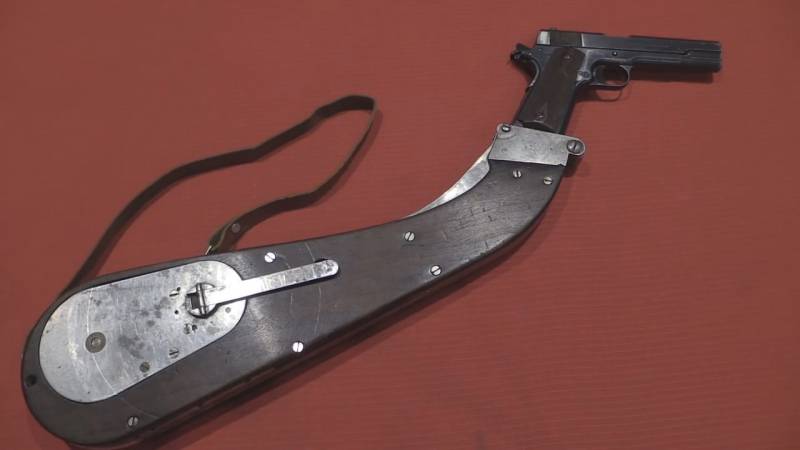
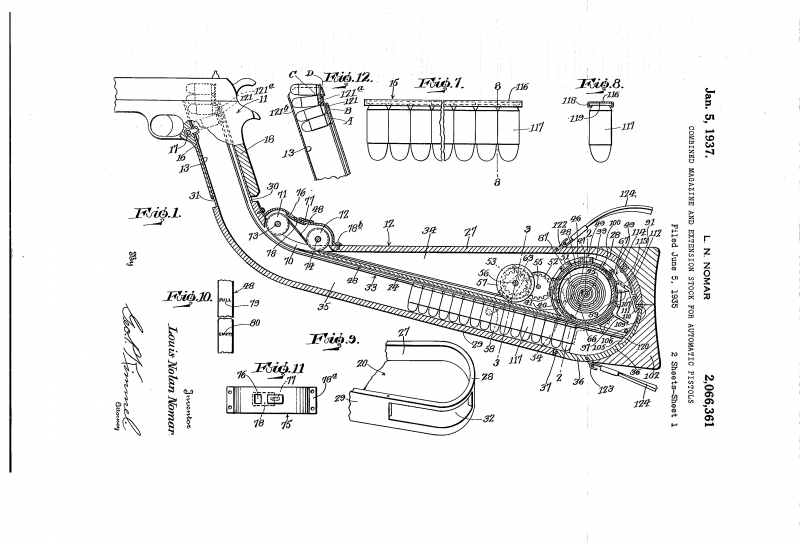
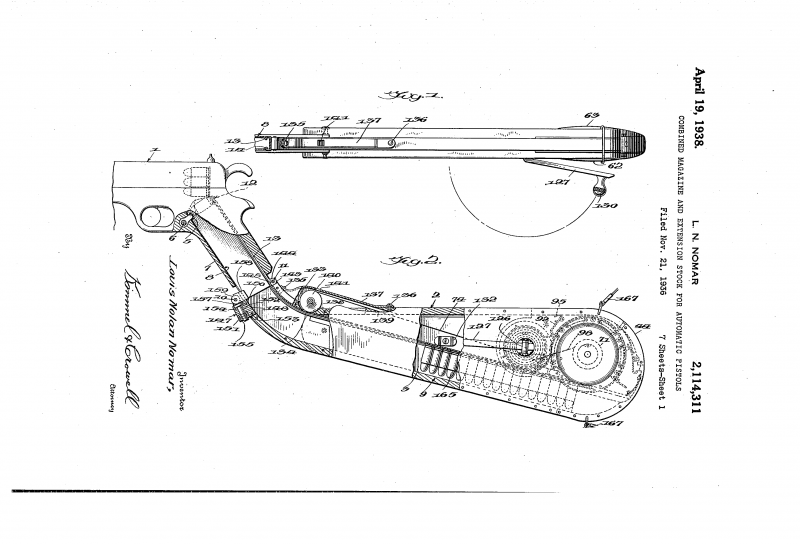
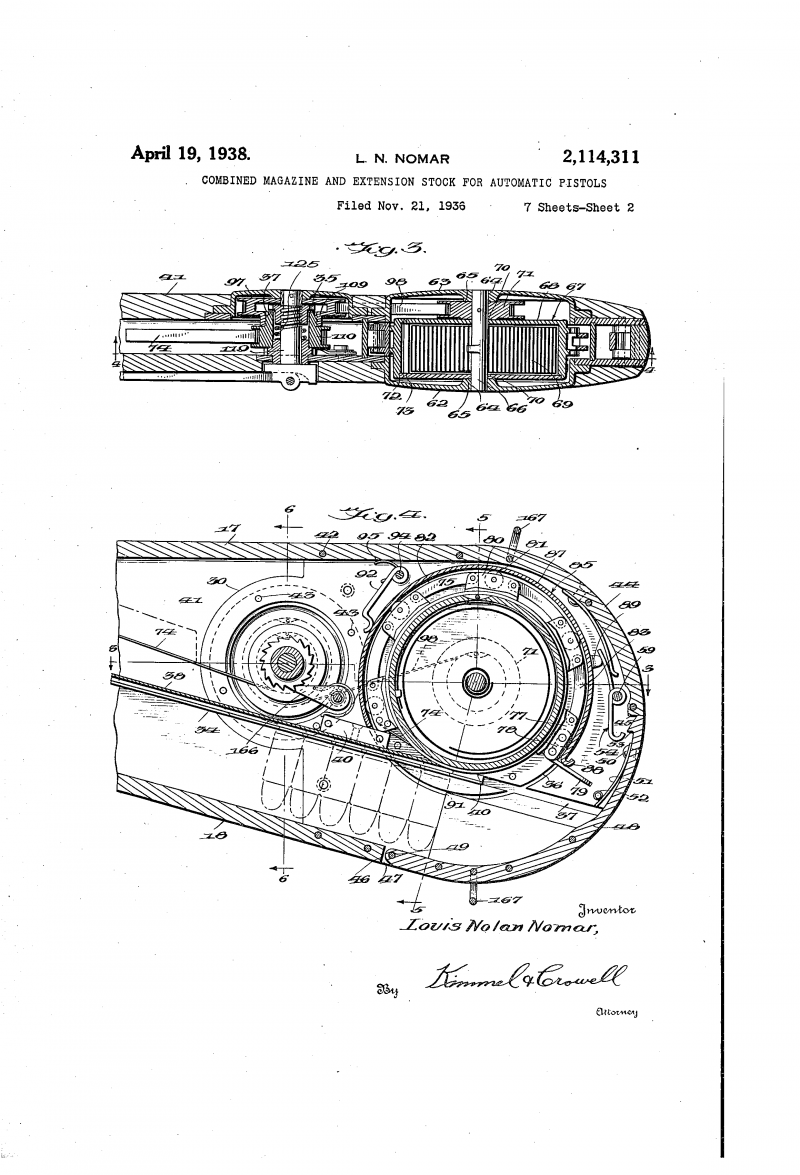
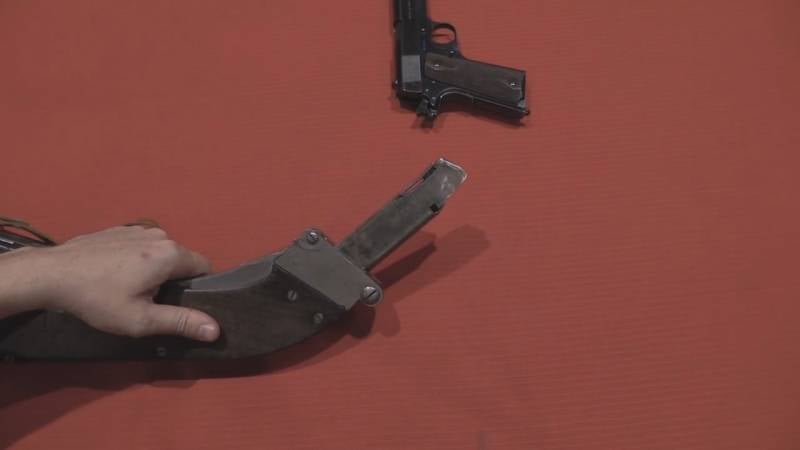
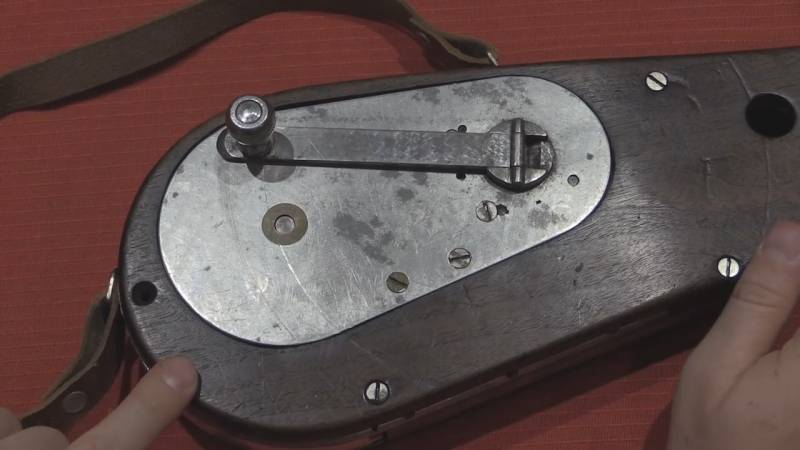
Information